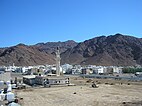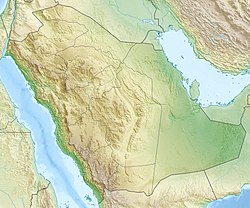Madinah
المدينة
| |
|---|---|
| Al-Madinah al-Munawwarah المدينة المنورة | |
| Coordinates: 24°28′12″N 39°36′36″E / 24.47000°N 39.61000°E | |
| Country | |
| Province | Medina |
| First settled | 9th century BCE |
| Hijrah | 622 CE (1 AH) |
| Saudi conquest of Hejaz | 5 December 1925 |
| Named for | Muhammad |
| Districts |
|
| Government | |
| • Type | Municipality |
| • Body | Madinah Regional Municipality |
| • Mayor | Fahad Al-Belaihshi[1] |
| • Provincial Governor | Prince Salman bin Sultan Al Saud |
| Area | |
| • City | 589 km2 (227 sq mi) |
| • Metro | 22,900 km2 (8,800 sq mi) |
| Elevation | 620 m (2,030 ft) |
| Highest elevation | 1,077 m (3,533 ft) |
| Population (2022 census)[2] | |
| • City | 1,411,599 |
| • Rank | 4th |
| • Density | 2,012/km2 (5,212/sq mi) |
| • Metro | 1,477,047 (Medina Governorate) |
| Demonym(s) | Madani مدني |
| Time zone | UTC+03:00 (SAST) |
| Website | www |
 | |
| Part of a series on |
| Islam |
|---|
 |
Medina,[a] officially Al-Madinah al-Munawwarah (Arabic: المدينة المنورة, romanized: al-Madīnah al-Munawwarah, lit. 'The Luminous City', Hejazi Arabic pronunciation: [al.maˈdiːna al.mʊˈnawːara]) and also commonly simplified as Madīnah or Madinah (المدينة, al-Madina), is the capital of Medina Province (formerly known as Yathrib) in the Hejaz region of western Saudi Arabia. It is one of the oldest and most important places in Islamic history. One of the most sacred cities in Islam, the population as of 2022 is 1,411,599, making it the fourth-most populous city in the country. Around 58.5% of the population are Saudi citizens and 41.5% are foreigners.[3] Located at the core of the Medina Province in the western reaches of the country, the city is distributed over 589 km2 (227 sq mi), of which 293 km2 (113 sq mi) constitutes the city's urban area, while the rest is occupied by the Hejaz Mountains, empty valleys, agricultural spaces and older dormant volcanoes.
Medina is generally considered to be the "cradle of Islamic culture and civilization".[4] The city is considered to be the second- serving as the holiest and third-holiest cities respectively. Al-Masjid al-Nabawi (lit. 'The Prophet's Mosque') is of exceptional importance in Islam and serves as burial site of the prophet Muhammad, by whom the mosque was built in 622 CE (first year of the Hijrah). Observant Muslims usually visit his tomb, or rawdhah, at least once in their lifetime during a pilgrimage known as Ziyarat, although this is not obligatory.[5] The original name of the city before the advent of Islam was Yathrib (Arabic: يَثْرِب), and it is referred to by this name in Chapter 33 (Al-Aḥzāb, lit. 'The Confederates') of the Quran. It was renamed to Madīnat an-Nabī (lit. 'City of the Prophet' or 'The Prophet's City') after Muhammad's death and later to al-Madinah al-Munawwarah (lit. 'The Enlightened City') before being simplified and shortened to its modern name, Madinah (lit. 'The City'), from which the English-language spelling of "Medina" is derived. Saudi road signage uses Madinah and al-Madinah al-Munawwarah interchangeably.[5]
The city existed for over 1,500 years before Muhammad's migration from Mecca,[6] known as the Hijrah. Medina was the capital of a rapidly increasing Muslim caliphate under Muhammad's leadership, serving as its base of operations and as the cradle of Islam, where Muhammad's ummah (lit. 'nation')—composed of Medinan citizens (Ansar) as well as those who immigrated with Muhammad (Muhajirun), who were collectively known as the Sahabah—gained huge influence. Medina is home to three prominent mosques, namely al-Masjid an-Nabawi, Quba Mosque, and Masjid al-Qiblatayn, with the Quba Mosque being the oldest in Islam. A larger portion of the Qur'an was revealed in Medina in contrast to the earlier Meccan surahs.[7][8]
Much like most of the Hejaz, Medina has seen numerous exchanges of power within its comparatively short existence. The region has been controlled by Jewish-Arabian tribes (up until the fifth century CE), the ʽAws and Khazraj (up until Muhammad's arrival), Muhammad and the Rashidun (622–660), the Umayyads (660–749), the Abbasids (749–1254), the Mamluks of Egypt (1254–1517), the Ottomans (1517–1805), the First Saudi State (1805–1811), Muhammad Ali of Egypt (1811–1840), the Ottomans for a second time (1840–1918), the Sharifate of Mecca under the Hashemites (1918–1925) and finally is in the hands of the present-day Kingdom of Saudi Arabia (1925–present).[5]
In addition to visiting for Ziyarah, tourists come to visit the other prominent mosques and landmarks in the city that hold religious significance such as Mount Uhud, Al-Baqi' cemetery and the Seven Mosques among others. The Saudi government has also carried out the destruction of several historical structures and archaeological sites, both in Medina and Mecca.[9]
- ^ "Fahad Al-Belaihshi Appointed Mayor of Madinah by a Royal Decree (Arabic)". Sabq Online Newspaper. 7 May 2020. Archived from the original on 12 April 2021. Retrieved 29 December 2020.
- ^ "Medina Governorate". City Population. Archived from the original on 4 February 2024. Retrieved 2024-02-03.
- ^ "Al-Madīnah (Al-Madīnah al-Munuwarah, Medina Region, Saudi Arabia) - Population Statistics, Charts, Map, Location, Weather and Web Information". City Population. Archived from the original on 4 February 2024. Retrieved 2024-02-04.
- ^ Lammens, H. (2013). Islam: Beliefs and Institutions. Routledge. p. 5. ISBN 9781136994302.
- ^ a b c Cite error: The named reference
:5was invoked but never defined (see the help page). - ^ "Masjid an-Nabawi at the time of Prophet Muhammad - Madain Project (En)". madainproject.com. Archived from the original on 30 September 2023. Retrieved 19 September 2023.
- ^ Abida Samiuddin; R. Khanam, eds. (2002). Muslim Feminism and Feminist Movement, Part 1, Volume 1. Global Vision Publishing House. p. 26. ISBN 9788187746409. OCLC 51217777.
- ^ Ahmed Al-Laithy (2005). What Everyone Should Know about the Qurʼan. Garant. p. 61. ISBN 978-90-441-1774-5. OCLC 319691554.
- ^ "Wahhābī (Islamic movement)". Encyclopædia Britannica. Edinburgh: Encyclopædia Britannica, Inc. 9 June 2020. Archived from the original on 26 June 2020. Retrieved 8 September 2020.
Because Wahhābism prohibits the veneration of shrines, tombs, and sacred objects, many sites associated with the early history of Islam, such as the homes and graves of companions of Muhammad, were demolished under Saudi rule. Preservationists have estimated that as many as 95 percent of the historic sites around Mecca and Medina have been razed.
Cite error: There are <ref group=lower-alpha> tags or {{efn}} templates on this page, but the references will not show without a {{reflist|group=lower-alpha}} template or {{notelist}} template (see the help page).






